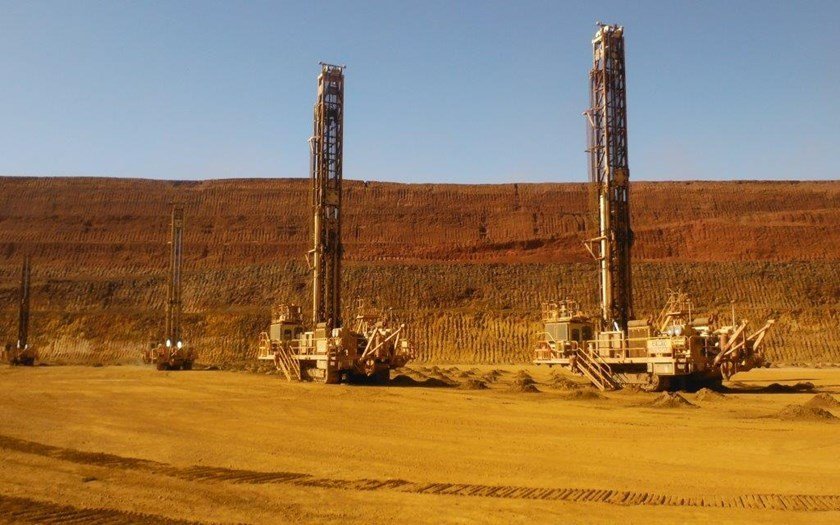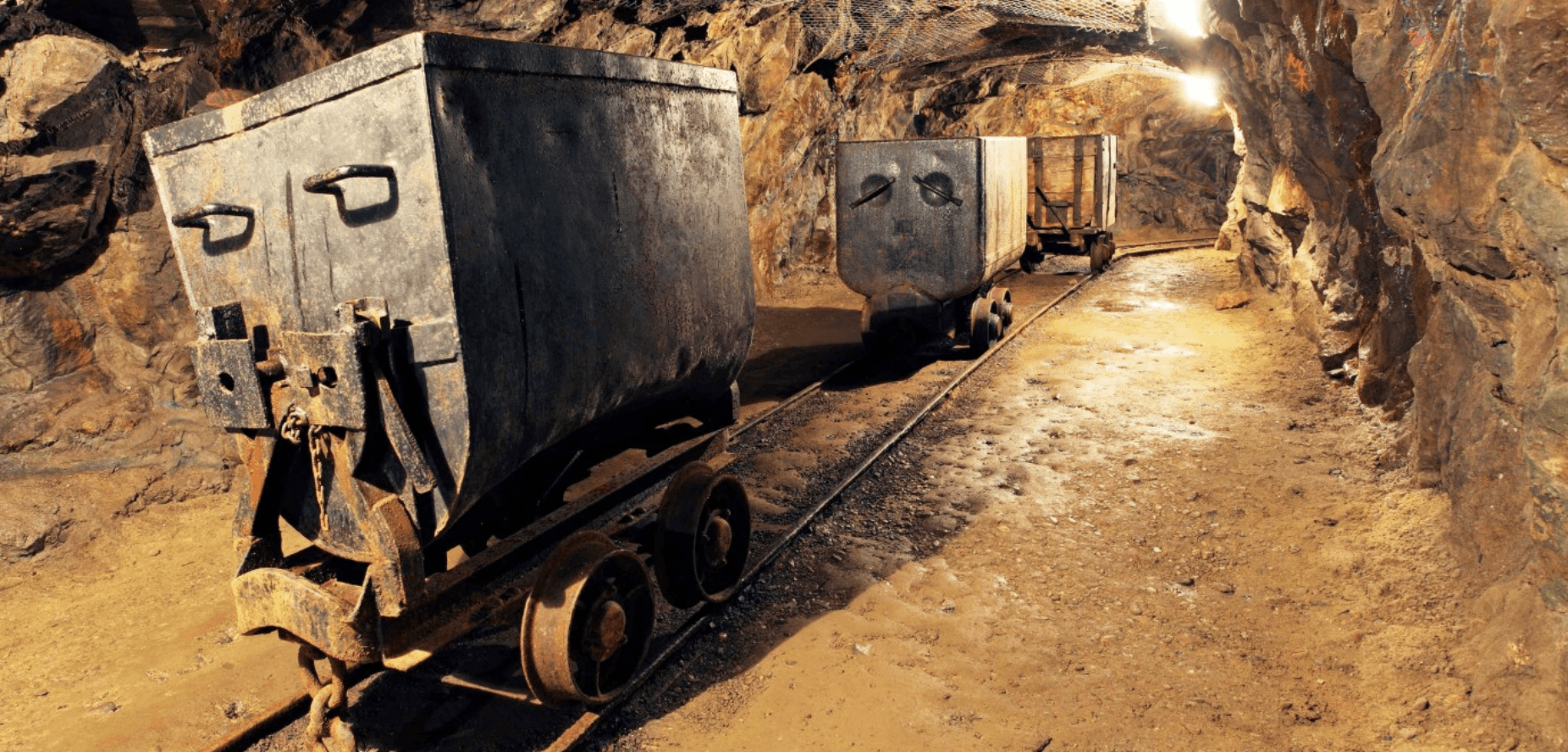Mining is a major worldwide industry producing everything from coal to gold. According to a PWC annual report, the top 40 mining companies have a market capitalization of $748 billion as of April 2017. The industry as a whole saw a slump in 2015 but since then the sector has recovered due to rising commodity prices.
The number of people directly working in the mining industry is relatively modest. In the United States roughly 670,000 people are employed in the mining, quarrying, and gas extraction sector as of September 2017. But the mining industry indirectly impacts nearly every aspect of the economy since it provides the raw materials needed for almost every sector from electronics; which often contain aluminum, cobalt, nickel, copper gold, platinum, etc… to energy; which use coal for power plans and aluminum for power lines; to construction/infrastructure which around the world used roughly 800 million metric tonnes of steel in 2014. The cost of almost every good or service is impacted at least in some small part by the mining industry.
Since mining companies are producing basically interchangeable commodities in large volumes, the industry is heavily focused on improving efficiency at all levels. Small improvements in speed, yields, and efficiency can often be what separate a profitable operation from an unprofitable one. This is what companies using artificial intelligence and machine learning are trying to do in this space.
This article examines how the mining industry is using or attempting to use AI to improve productivity and efficiency throughout the process. We’ll cover:
- The various mining processes where AI is being tested and applied
- Specific mining AI use-cases and initiatives from established mining companies
- Preliminary results from the present applications of AI in mining
Mining is a large and diverse industry with significantly different techniques and technologies used depending on what material is being extracted, so it difficult to make sweeping statements that fully encompass the entire sector. That said, this article will look at how AI is being used to find ground to mine and how AI is being used to improve mine operations.
Mineral Exploration
The first step is finding a place to mine. This mineral exploration step is critical to mining operations. A company could build the most aggressively automated and impressively efficient operation and it would be worthless unless there were good material in the ground to extract. Applying artificial intelligence and machine learning to the task of mineral prospecting and exploration is a very new phenomenon, which is gaining interest in the industry
At the 2017 Disrupt Mining event in Toronto, Canada, two of the five finalists were companies focused on using machine learning in mining: Kore Geosystems and Goldspot Discovery.
Gold Exploration – Goldspot Discoveries Inc.
The company Goldspot Discoveries Inc. uses AI to try to improve mineral exploration. The company claims that the current practice of trying to find gold deposits is more of an art than a science, and they plan to change that with machine learning as they explain in their video.
They claim in their test they were able to predict 86% of the existing gold deposits in the Abitibi gold belt region of Canada using data such as geological, topography, and mineralogy from just 4 percent of total surface area. The first major publicly announced test of their system will be happening in the near future at the Jerritt Canyon mine.
Last month the Jerritt Canyon project announced they used Goldspot Discoveries Inc’s AI to analysis all geological data they have about the currently un-mined parts of their claim and information about where they have previously found gold in the region to identify target zones that might contain gold. The gold producer plans to perform preliminary drill testing as soon as is logistically possible.
Goldspot Discoveries Inc. also claims to have a deal with an unnamed publicly listed African exploration company to drill a few test holes based on the companies AI targeting.
Improving Exploration Targets – Goldcorp and IBM Watson
It is not just startup companies looking at using AI in mineral exploration. Earlier this year mining giant Goldcorp teamed up with IBM Watson to comb through a vast quantity of geological information to find better targets. Goldcorp is one of the largest gold mining companies in the world. In this video IBM explains how their technology is being used in mining.
The first place Goldcorp is using Watson is at their Red Lake mine in Ontario. The operation’s High Grade Zone could be depleted by 2020. Goldcorp is hoping Watson can help them choose the best possible exploration targets in the area.
While it is too early to say whether AI has succeeded in helping to find gold, IBM Watson claims it has been used successfully for years by oil and gas companies for exploration purposes.
Improve Mine Operations
Where AI is most directly in use in the mining industry right now is to improve efficiency. Mines are often giant industrial operations. Many of them are using the same basic advances in robots and smart sensors that we see in factories to improve their performance in mining.
Self-Driving Haulers – Rio Tinto, Volvo
Mines are heavy industry that actually makes them ideal place for the early commercial use of self-driving vehicles. Mine equipment and trucks tend to travel relatively slowly. They also operate in well defined and highly controlled areas. Trucks used at a mine don’t need to worry about events like children chasing a ball into the middle of the street or erratic drunk drivers, which make it so challenging to program an autonomous vehicle to operate perfectly on urban roads. That is why they have already been deployed at mines for years.
The mining company Rio Tinto has lead the way in the use of this technology. They have been steadily expanding their giant autonomous ore hauling truck fleet for years and now currently use a fleet of 76 trucks at their mining operations in Australia. The trucks are produced by Japanese manufacturer Komatsu and remotely overseen by operators in Perth.
According to Rio Tinto the trucks are safer and roughly 15 percent cheaper to operate than ones with humans behind the wheel. The trucks can operate 24/7 without the need to stop for shift changes or bathroom breaks. This video below shows how they work and how the controlled environment of a mine makes it an easier way to use the technology.
Rio Tinto is not the only company that has been using autonomous vehicles at mines. This July, after years of testing, BHP announced there Jimblebar mine was going to switch to completely autonomous trucks using the 50 Caterpillar 793F. In the video they explain how they are using it and the benefits it offers.
Earlier this year Volvo announced they had started testing a fully autonomous truck underground in the Kristineberg Mine. This was a technical step forward, since the vehicle can’t make use of GPS when it’s underground like autonomous trucks at surface mines do. The truck is able to navigate the very narrow tunnels which make up the mine.
Autonomous Drills, Loaders, and Trains – Rio Tinto
These same mining companies aren’t just using autonomous trucks but are trying to make their entire operations autonomous. Rio Tinto has also been using autonomous loaders, which scope up dirt, and autonomous blast-hole drill system for several years. Their drilling system lets one remote operator control multiple drilling rigs to drill into the ground. The company claims their autonomous drills improve productivity by roughly 10 percent.

In the near future Rio Tinto also plans to have the world’s first fully autonomous long haul rail system. If all goes as planned, it expects to have a fully autonomous train system by 2018. This video shows their autonomous train in action.
AI for Sorting – TOMRA
Mines tend to remove a huge volume of material out of the ground even though the minerals they are after make only a small part of the told volume they remove. Separating the material they want from the worthless dirt, rocks, and clay can be a very expensive step in the mining process.
In addition, the earlier in the process this sorting takes place the less fuel and money the company wasted moving useless material. Machine learning has only relatively recently been used to improve this process in the mining sector.
TOMRA has developed smart sorting equipment for mining which uses color-sorting, X-ray transmission or near-infrared sensors to examine every single piece of material moving through the equipment and is able to sort the material based whatever criteria the company wants. They use it for everything from ore to diamonds.
They claim that use of their sorting equipment at the Boliden mining company resulted in 12 percent less mass needing to be moved. This means less fuel, less energy during processing, and fewer truckloads. This video shows the sort in use as it rapidly sorts out desired material and eliminates unwanted rock.
The most high profile success for TOMRA sorting equipment is it helped recover a 227 carat diamond from the Lulo mine in Angola. This one diamond more than paid the cost of the entire TOMRA large diamond recovery system.
Equipment Monitoring – PETRA, GE
Cheap connective sensors have made it possible for companies constantly monitor almost all aspects of their equipment. Analyzing all this data with AI programs could also improves maintenance, reduces downtime, and helps predict problems before they happen (readers with a more direct interest in this topic may want to reader our “predictive maintenance” interview with Talik Kasturi).
Companies such as GE and PETRA offer these services to mining companies. PETRA claims their use of algorithms at Newcrest Mining’s Lihir operation allowed the company to significantly reduce the number of overload events experienced by their semi-autogenous grinding (SAG) mills. Any such overload event effectively stops the mine from operating, and any downtime is a major loss of money.
Concluding Thoughts on AI Applications in Mining
Mining is about producing commodities, so staying competitive in this sector generally means producing faster and cheaper. When you are processing literally tons of material an hour any small improvement in downtime, processing, or labor costs can lead to significant savings.
The nature of the industry means mining companies are hyper focused on any way to improve productivity and efficiency. So it is not surprising that some mining companies have been very aggressive about use artificial intelligence, machine learning, and autonomous equipment to find ways to improve efficiency.
We’ve covered AI in heavy industry in previous articles, and we’re of the belief that mining may be a pivotal test bed for AI innovation – particularly for autonomous vehicles and equipment operating in controlled mining environments (where the regulatory concerns of commercial autonomous vehicles won’t be as much of an issue).
In some parts of the process, like mineral exploration, the use of AI is relatively new. While this application of AI has generated some real attention from major industry players, it is still in the early stages and not yet clear how big of an impact it will have.
When it comes to the running of existing mines, though, the use of AI and autonomous equipment is already well established and delivering very tangible benefits. Autonomous equipment and smart equipment is changing the industry. Many applications have been well tested and are being rapidly expanded to new mine operations. The fact Rio Tinto and its rivals have been significantly growing autonomous haulers fleets for several years is a strong proof there are applications where they provide a positive return on investment.
Parts of the mining sector are already are on the cutting edge of the use of smart and autonomous equipment and will likely continue to be that way for the foreseeable future. Mining is relatively unique in that it requires big capital investments in extremely expensive pieces of large equipment, and a main way to be competitive is a ruthless focus on efficiency. This is going to always make the industry a logical choice for pushing envelope when it comes making equipment smarter. The marginal cost of adding an autonomous system to a car is significant while it barely makes a difference when adding one to a $5 million 300-ton haul truck.
If you want to get a glimpse of how numerous other industries might operate in the future, examining how some of these nearly fully autonomous mines operate in Australia might offer some of the best insight.
Header image credit: Kapuskasing Now


















